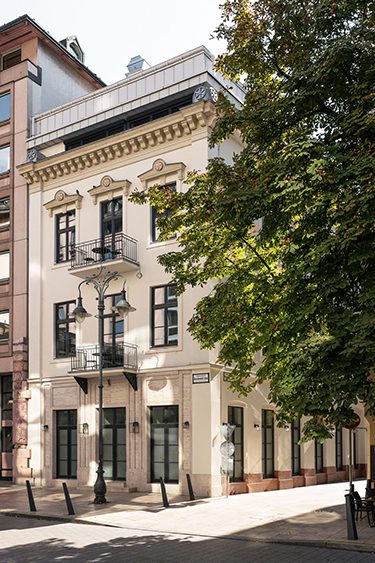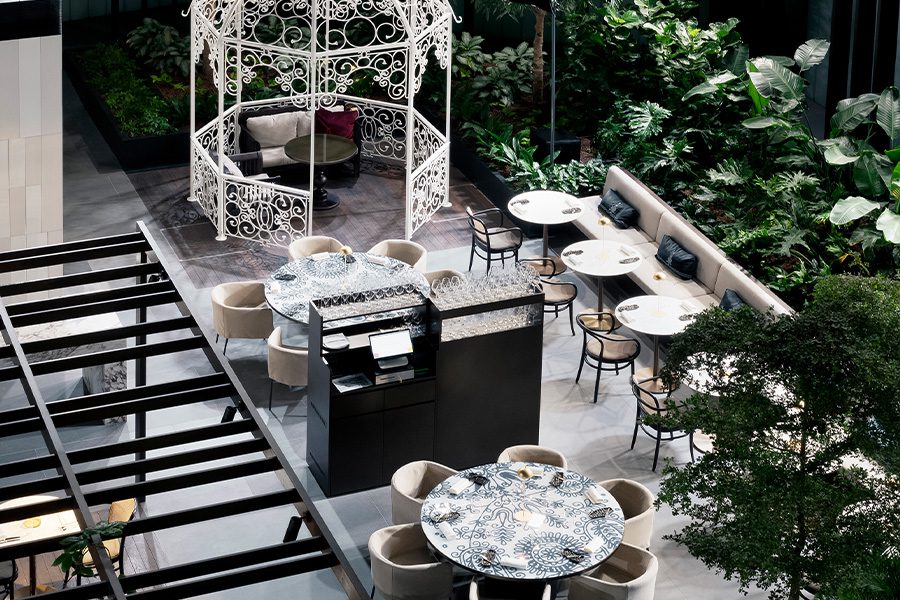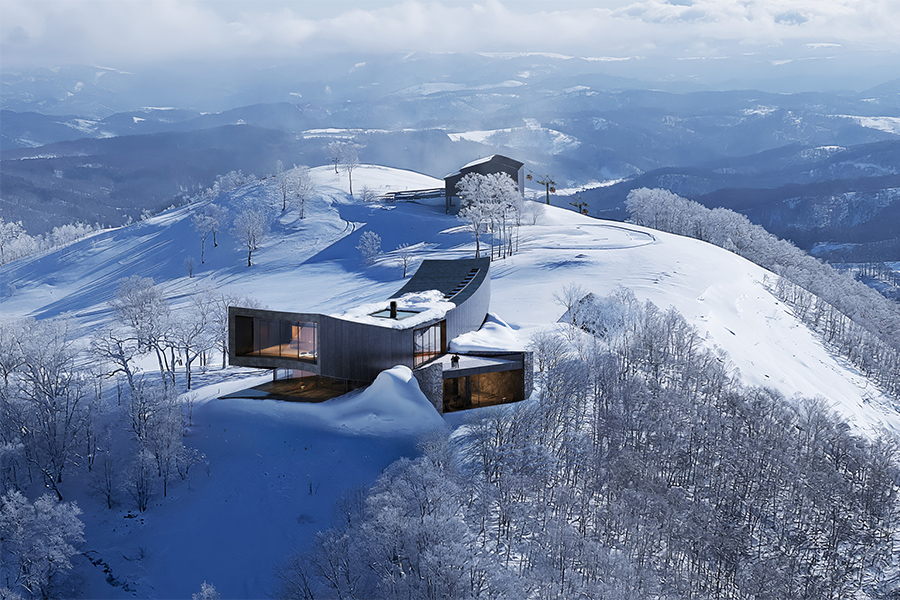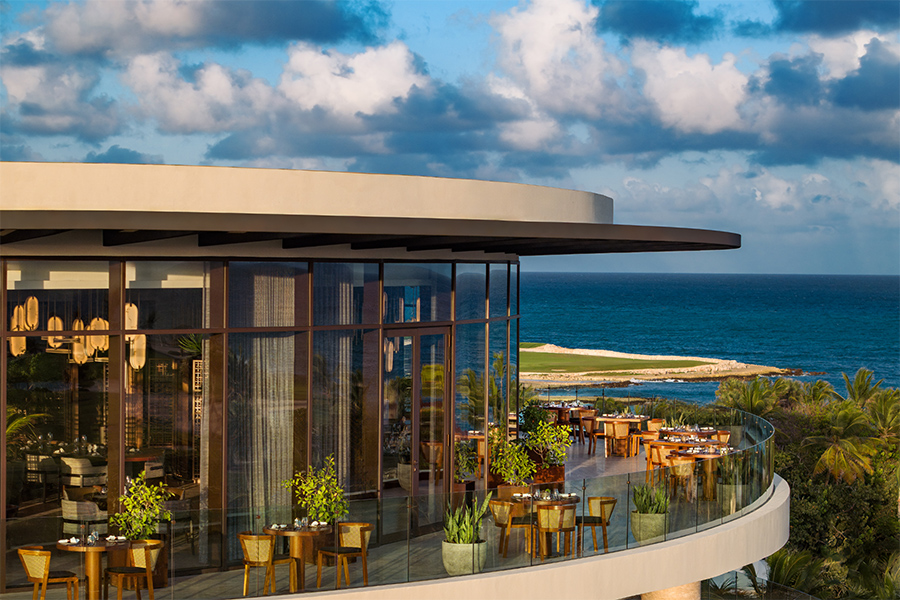For years, Budapest’s striking Drechsler Palace, a late 19th-century UNESCO World Heritage Site located directly across from the Hungarian State Opera House, was an abandoned ruin. Finally, in June 2023, the neo-renaissance structure found new life as the 151-key W Budapest, thoughtfully restored by local architecture firm Bánáti + Hartvig and London design consultancy Bowler James Brindley. Animated by a constellation of metallic meshing, dramatic archways, and jewel tones, it unleashed an enticing energy that now permeates the Hungarian capital’s booming hotel scene.
Meanwhile, a modernist aura pervades Boho Hotel Budapest. Part of the Small Luxury Hotels of the World collection, the 64-room property designed by Barcelona- and Madrid-based GCA Architects is a sleek juxtaposition to the city’s bohemian Palace District. Close to the cinematic Metropolitan Ervin Szabó Library, its neutral-toned guestrooms flaunt high ceilings, detailed moldings, and floor-to-ceiling windows, while suites illuminate terraces, expansive bookshelves, and a profusion of glass and rustic wooden beams.

The city’s District VIII is enlivened by the arrival of the Boho Hotel Budapest
This development streak is poised to continue, underscoring Budapest’s appeal as a top European travel destination. The Hungarian Tourism Agency (MTU) reports that in 2024, the city attracted nearly six million visitors, a 24 percent year-over-year increase. Further, according to Lodging Econometrics, there are 19 hotels in Budapest’s pipeline, which will bring 3,128 guestrooms to the city, and some of them are already generating buzz.
Consider the Mandarin Oriental Gellert, a transformation of the iconic Hotel Gellért built in 1918. Slated to reopen in 2027, the 143-room property, courtesy of local firm Archikon and London studio Alexander Waterworth Interiors, will stay true to its Art Nouveau roots. The landmark hotel is part of the BDPST Group portfolio, which also includes the 48-room Verno House Budapest designed by local practice BIS that joined IHG’s Vignette Collection in 2024.
Time Out Market Budapest will also make a splash when it opens in the former department store Corvin Palace this summer. A fusion of food, drink, and culture, it will be complemented by the first Hungarian outpost of Ruby Hotels, a 181-room property designed in-house that is planned for 2026.
On the heels of such rebrands as the Hard Rock Hotel Budapest’s conversion to a Pullman and the Ritz-Carlton Budapest now under the Al Habtoor Palace flag, in 2026 the Sofitel Budapest Chain Bridge will be reimagined as the 350-key SO/, part of Ennismore’s collection of lifestyle hotels.
Here is a look at three properties currently turning heads in Budapest.
Dorothea Hotel, Budapest, Autograph Collection

Deep blue velvet sofas contrast a monochromatic palette at the Dorothea Hotel
Another BDPST Group venture, the Dorothea comprises a trifecta of historic structures that Milan- and New York-based Lissoni & Partners stitched together with “delicacy and care,” points out founder and design principal Piero Lissoni. “How we treated the façades, how we integrated the buildings, and how we designed the terraces, the suspended gardens, and the new courtyard was done with a great deal of subtlety.”
At the 216-room hotel in the city center, original staircases are emboldened by swaths of red and blue glass and works from local artist Zoltán Tombor mingle with regal columns and curving banquettes. “We were inspired by Budapest, with its architecture formed by different layers of time. We tried to combine the allure of the past with a contemporary design,” explains Miguel Casal Ribeiro, architecture coordinator and project manager at Lissoni & Partners.

Artworks, made in collaboration with Zoltán Tombor, are enhanced by blue accents at the Dorothea Hotel
The Dorothea’s appeal is heightened by its F&B venues, including two clamored-for restaurants from Spanish chef Dani García, both of which feature the handiwork of Barcelona design studio Astet. First came a branch of Alelí, a nod to the Tuscan countryside, followed by García’s recently opened BiBo rooftop concept.
Backdropped by a palette of petroleum blue, burnt orange, and soft salmon, BiBo showcases intimate alcoves forged by an arrangement of banquettes and a bespoke carpet that recalls the celestial landscape. “Overhead, cascading floral installations in soft ivory hues spill from the ceiling, while delicate transparent spheres—each encasing preserved flowers and birds—appear to float in mid-air,” says Ala Zreigat, managing partner and CEO at Astet. “These elements combine to heighten the dreamlike ambiance, inviting diners into a world that feels both enchanting and timeless.”
Kimpton BEM Budapest

Colorful front desks planted underneath concave ceilings greet guests at the Kimpton BEM Budapest
Equally magical is the Kimpton BEM Budapest from local architectural practice 3h and Amsterdam designer Marcel Wanders. Throughout, Wanders paid homage to Hungarian folklore with motifs depicting mythological creatures and native flora like poppies and tulips.
In the lobby, reception desks reminiscent of inverted Easter eggs lead to a glass-surrounded sculptural golden stag. To the left is Bar Huso, its blue tones calling to mind Huso Huso, the legendary Beluga sturgeon. These vignettes, including corridors wrapped in prints of old Hungarian book spines, set a playful tone for the 127 guestrooms.

The cozy Turul Chamber, a private wine tasting room at the Kimpton BEM Budapest
Given the hotel is on the residential Buda side, away from the crowds, Budapest denizens also appreciate the setting. It’s not uncommon to see locals dining in front of the open kitchen at the airy Agos, for instance, or drinking cocktails on the roof at Fennen, where the bar sparkles in an elegant greenhouse.
“The city has seen a steady increase in tourism, with visitors drawn to its thermal baths, historic sites, and lively nightlife, which aligns with Kimpton’s target demographic,” says Miguel Martins, head of development, Northern Europe at IHG. “[Our hotel] brings a fresh vibe to the local hospitality scene.”
Hotel Gin

The exterior of Hotel Gin, a revamped historic building in Budapest’s District V
When Szonja Lefkovics opened Hotel Rum in Budapest’s District V in 2016, it was an immediate hit. Nine years later, locals still flock to its rooftop for brunch. Since then, Lefkovics has expanded her hospitality footprint by opening sister property Hotel Gin, just a few minutes away.
Like Hotel Rum, the 35-room Hotel Gin was designed by local studio B.A.D with a lighter, softer aesthetic that makes way for a sprawling sofa in the lobby and capacious headboards and carpets emblazoned with undulating patterns in the guestrooms.
Just as notable as Hotel Gin’s winding staircase are remnants of the Pest city wall dating back almost 1,000 years that run through the property.
“We combined this medieval tradition with the modern Deco ones that have a very strong history in Budapest,” explains B.A.D founder and chief designer Ákos Dániel Bara. “Our goal was to achieve a design identity that harmonizes with the heritage building, yet exudes a bright, downtown atmosphere.”
Photos by Daniel Dömölky, Salva Lopez, Daniel Molnar, Tommaso Sartori, Marietta Varga, and courtesy of Kimpton and Boho Hotel Budapest
This article originally appeared in HD’s February/March 2025 issue.



